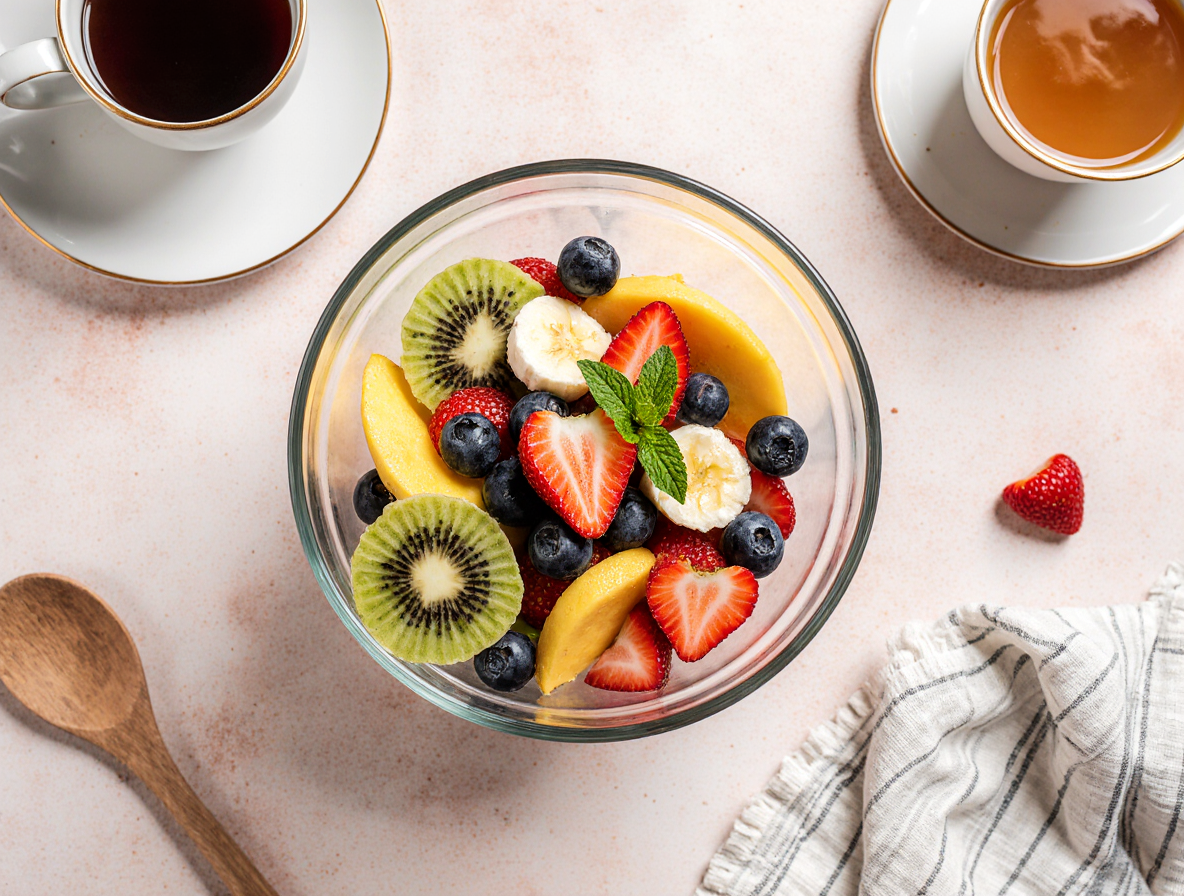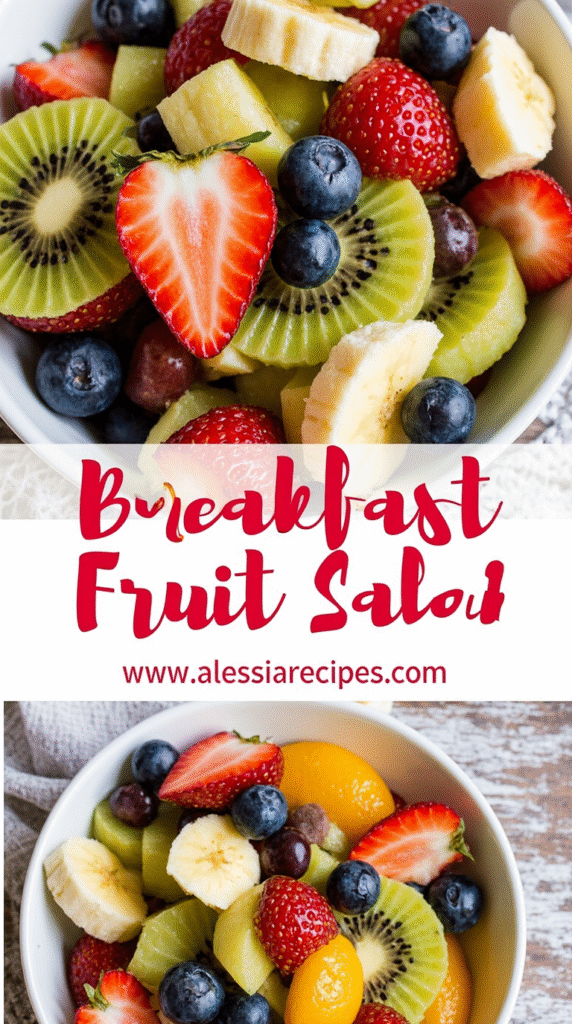How to Make the Perfect Breakfast Fruit Salad in 15 Minutes (Step-by-Step Guide)
Did you know a breakfast fruit salad can earn well over a dozen 5-star reviews and take just 15 minutes to prepare?
This vibrant, nutrient-packed dish has become a morning staple in my home, and for good reason! Not only is it an easy way to load up on essential vitamins, but it’s also incredibly versatile. You can enjoy it as a standalone breakfast, use it to top your morning oatmeal, or serve it as part of a larger brunch spread.
What makes fruit breakfast ideas like this so appealing is their perfect balance of simplicity and impact. In fact, this particular breakfast fruit recipe delivers a colorful array of flavors that will brighten your morning routine. Additionally, regularly enjoying fruit salads can help you reach your dietary goals while reducing disease risk.
If you’re looking for an easy breakfast fruit salad that’s both satisfying and ready in minutes, you’ve come to the right place! In this step-by-step guide, I’ll walk you through creating the perfect breakfast fruit salad recipe that’s sure to please everyone at your table.
Choose and Prep the Right Fruits
Selecting the right fruits forms the foundation of any delicious breakfast fruit salad. I’ve learned through trial and error that certain fruits shine in morning preparations while others can quickly turn your beautiful creation into a soggy mess.
Best fruits for breakfast salad
The perfect breakfast fruit salad typically includes a mix of textures, colors, and flavors. Berries like strawberries, blueberries, and blackberries work wonderfully because of their high antioxidant content and natural sweetness. Furthermore, sturdy fruits like grapes (preferably seedless), kiwi, and pineapple chunks add interesting textures and tropical notes.
For a balanced breakfast fruit salad, consider these combinations:
- Tropical blend: Pineapple, kiwi, and mandarin oranges
- Berry delight: Strawberries, blueberries, and grapes
- Seasonal mix: Whatever fruits are currently in season for maximum freshness
Fruits to avoid for texture or flavor
Though I love all fruits individually, some simply don’t belong in a breakfast fruit salad. Bananas quickly turn brown and mushy, ruining the salad’s appearance and texture. This happens because bananas release ethylene gas, especially when cut, accelerating the ripening process. Similarly, apples oxidize rapidly after cutting, turning an unappealing brown.
Watermelon and cantaloupe, despite their popularity, contain approximately 90-91% water. Consequently, they release excess moisture, making your salad watery and diluting the flavors of other fruits.
Pineapple requires special consideration since it contains bromelain, an enzyme that can break down other fruits and create unpleasant textures when combined with softer options like berries.
How to cut fruit for visual appeal
Proper cutting techniques enhance both presentation and eating experience. First, thoroughly wash and dry all fruits before cutting to remove contaminants. Moisture is the enemy of fruit salad freshness, hence thorough drying is essential.
For maximum visual impact, aim for uniform, bite-sized pieces that showcase different shapes. Cut strawberries into quarters, slice kiwi into rounds then quarters, and leave small berries whole for textural contrast. Meanwhile, consider using a melon baller for cantaloupe if you decide to include it despite its high water content.
The goal is creating a colorful mix with various textures that’s still easy to eat – nobody wants to chase large fruit chunks around their breakfast bowl!
Make the Citrus Dressing
A simple citrus dressing elevates your breakfast fruit salad from ordinary to extraordinary. Unlike store-bought options that often contain preservatives, making your own takes just minutes yet creates a remarkably fresh flavor profile.
Simple ingredients for a fresh dressing
The perfect citrus dressing requires surprisingly few ingredients. At its core, most fruit salad dressings combine:
- Citrus juice: Orange juice creates a naturally sweet base, often complemented by lemon or lime juice for brightness
- Sweetener: Honey adds complexity while balancing citrus acidity
- Zest: Freshly grated citrus zest intensifies flavor without additional liquid
For a basic honey-citrus dressing, whisk together the juice and zest of half an orange, juice of half a lemon, juice of half a lime, and one tablespoon of honey. Alternatively, combine ¼ cup honey with ¼ cup orange juice and a tablespoon of lemon zest for a sweeter variation.
Why citrus helps preserve freshness
Beyond flavor enhancement, citrus serves a practical purpose. The acid in citrus juice prevents fruits like apples and pears from browning by slowing oxidation. This preservative effect explains why many recipes recommend tossing cut fruit with a few tablespoons of orange juice before adding the complete dressing.
Orange, lemon, lime, and even pineapple juices all contain sufficient acidity to maintain your breakfast fruit salad’s vibrant colors and textures. Moreover, this natural preservation method eliminates the need for artificial preservatives.
Optional sweeteners and spices
Although honey remains popular in fruit salad dressings, numerous alternatives exist. Maple syrup, agave nectar, or coconut sugar can replace honey while offering distinct flavor profiles. For those seeking seasonal variations, consider:
- Fall/winter: Add apple pie spice or cinnamon to orange juice base
- Spring/summer: Incorporate fresh mint or vanilla extract
The dressing can be prepared a day ahead and refrigerated, offering convenience for busy mornings. Just bring it to room temperature for 15 minutes before gently tossing with your prepared fruits.
Assemble Your Breakfast Fruit Salad
Now that you’ve prepared your fruits and mixed up your dressing, it’s time to bring everything together. Assembling your breakfast fruit salad properly ensures maximum freshness and visual appeal that will make your morning meal truly enticing.
Step-by-step mixing process
Initially, select a large glass or clear bowl that provides ample room for gentle tossing. Place all your chopped fruits (except bananas) in the bowl, ensuring each piece is completely dry to prevent excess moisture.
For the perfect assembly:
- Pour your prepared citrus dressing over the fruit just before serving
- Using two large spoons, gently toss everything until the fruits are evenly coated
- Lift from the bottom of the bowl to avoid crushing delicate berries
The layering method offers another appealing approach. Try arranging fruits in a clear bowl in this sequence: pineapple, strawberries, kiwi, oranges, grapes, then blueberries on top. Subsequently, pour your cooled dressing over everything for a stunning visual effect.
When to add delicate fruits like banana
Timing matters greatly with certain fruits. Bananas should always be added last or immediately before serving. Even with citrus dressing, bananas quickly turn brown and mushy, potentially ruining your breakfast fruit salad’s appearance.
Likewise, save blueberries for just before serving if you’re planning to store the salad for more than a couple days. Throughout my experimentation, I’ve noticed that overly ripe raspberries should be avoided entirely as they quickly disintegrate.
Tips for even coating and presentation
For a professionally assembled breakfast fruit salad, consider these presentation strategies:
First, aim for uniform bite-sized pieces to ensure your salad is easy to eat. Equally important is balancing the fruit proportions—no single fruit should dominate the entire dish.
To create visual interest, combine contrasting colors like reds (strawberries), yellows (pineapple), greens (kiwi), and purples (blueberries). Garnishing with fresh mint leaves adds a vibrant finishing touch that enhances both appearance and flavor.
Finally, for special occasions, consider serving in hollowed-out fruit “bowls” like cantaloupe halves for an impressive presentation.
Store, Serve, and Customize
Properly stored breakfast fruit salad brings convenience to busy mornings. Let me share proven methods to keep yours fresh for days.
How to store and meal prep ahead
Store your breakfast fruit salad in an airtight container in the refrigerator for optimal freshness. This method helps maintain texture and flavor for up to 3-5 days. For meal prep, consider dividing portions into individual cups or mason jars. Primarily, remember that bananas don’t store well – add them just before serving to prevent browning. Undoubtedly, a citrus-based dressing helps preserve color and freshness, essentially acting as a natural preservative.
Serving ideas for brunch or weekday breakfast
A beautiful breakfast fruit salad complements heavier morning offerings perfectly. Serve alongside quiche, stuffed French toast, or as part of a build-your-own yogurt bar where guests create custom parfaits. For weekday efficiency, portion prepared fruit into grab-and-go containers. The salad scales beautifully from solo breakfast to elegant brunch centerpiece.
Add-ins like yogurt, granola, or nuts
Elevate your breakfast fruit salad with protein-rich additions. A dollop of Greek yogurt creates a creamy contrast. Crunchy granola should always be added immediately before eating to maintain texture. Consider nuts like almonds, walnuts, or pecans for healthy fats and satisfying crunch.
Seasonal variations to try
Rotate fruits seasonally for peak flavor:
- Spring: Strawberries, blueberries, bananas
- Summer: Watermelon, cantaloupe, honeydew
- Fall: Apples, grapes, pears, pomegranate
- Winter: Pineapple, mango, kiwi, citrus
These seasonal combinations ensure your breakfast fruit salad stays exciting year-round while featuring the freshest produce available.
Conclusion
Creating the perfect breakfast fruit salad truly transforms morning routines with minimal effort and maximum impact. Throughout this guide, we’ve explored how a vibrant mix of carefully selected fruits can deliver essential nutrients while delighting your taste buds in just 15 minutes. Most importantly, the right combination of fruits makes all the difference—berries, grapes, and tropical options provide ideal texture and flavor, while problematic choices like bananas and watermelon require special handling.
Additionally, a simple citrus dressing serves as both flavor enhancer and natural preservative, keeping your creation fresh and visually appealing. This small step elevates your breakfast from ordinary to extraordinary without complicated ingredients or techniques. The assembly process, though straightforward, benefits from attention to detail—gentle tossing, proper timing for delicate fruits, and thoughtful presentation.
Perhaps the greatest advantage of mastering this breakfast staple comes from its incredible versatility. You can enjoy it alone, pair it with yogurt or granola, or serve it as part of an impressive brunch spread. Seasonal variations ensure you’ll never tire of this healthy morning option, while proper storage techniques make meal prep convenient for busy weekdays.
Therefore, I encourage you to try this simple yet impactful breakfast option tomorrow morning. Your body will thank you for the nutrition, your taste buds will appreciate the fresh flavors, and your schedule will benefit from the quick preparation time. Breakfast fruit salad might seem basic at first glance, but as we’ve seen, attention to detail transforms this simple dish into something truly special that can brighten your mornings all year round.
FAQs
Q1. How can I make a quick and easy breakfast fruit salad? To make a quick breakfast fruit salad, choose fruits that are easy to prepare like berries, grapes, and pre-cut tropical fruits. Wash and dry the fruits, cut them into bite-sized pieces, and gently toss them with a simple citrus dressing. The entire process should take about 15 minutes.
Q2. What are the best fruits to include in a breakfast fruit salad? The best fruits for a breakfast salad include a mix of berries (strawberries, blueberries, blackberries), grapes, kiwi, and pineapple chunks. These fruits offer a variety of textures, colors, and flavors while holding up well in the salad.
Q3. How can I keep my fruit salad fresh and prevent browning? To keep your fruit salad fresh and prevent browning, use a citrus-based dressing. The acid in citrus fruits like oranges and lemons helps preserve the fruits’ colors and textures. Store the salad in an airtight container in the refrigerator, and add delicate fruits like bananas just before serving.
Q4. What are some healthy additions to make my fruit salad more filling? To make your fruit salad more filling, consider adding protein-rich Greek yogurt, crunchy granola, or nuts like almonds or walnuts. These additions not only increase the nutritional value but also add interesting textures and flavors to your breakfast.
Q5. How can I adapt my fruit salad for different seasons? Adapt your fruit salad seasonally by using fruits at their peak. For example, use strawberries and blueberries in spring, watermelon and cantaloupe in summer, apples and grapes in fall, and citrus fruits and kiwi in winter. This ensures you’re always using the freshest, most flavorful fruits available.


